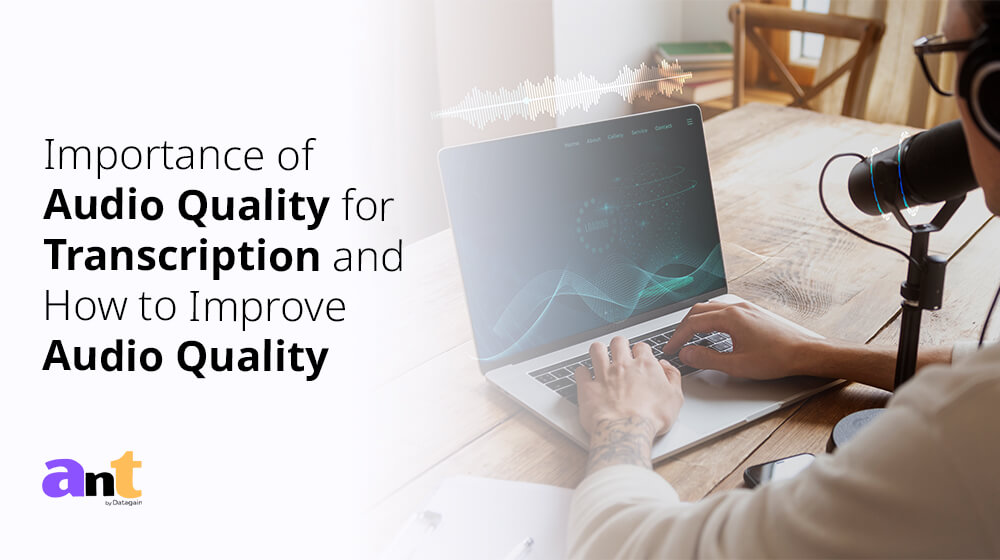Transcription is vital in market research, providing researchers with a precise and comprehensive record of interviews, focus groups, and other data-gathering activities. It allows detailed examination, easy referencing, and future archiving by converting spoken content into written form.
This blog explores the significance of transcription in market research, highlighting its contributions to data analysis, decision-making, inclusivity, and the overall success of research endeavors.
1. Mitigating misinterpretations & easy record-keeping
Transcriptions play a crucial role in minimizing the risk of misinterpretation. In fast-paced interviews or group discussions, participants may express their thoughts in complex or ambiguous ways. By transcribing the spoken content, researchers can carefully review and interpret the responses more deliberately. It helps reduce the chances of misinterpreting or misrepresenting participants’ viewpoints, leading to more accurate and reliable research outcomes.
Transcriptions can be easily stored and archived for future reference. Market research findings are often used for decision-making and product development. By maintaining a record of transcriptions, companies can refer back to the original data when needed. It ensures that decisions are based on a reliable source of information. Moreover, transcriptions can be shared with stakeholders, executives, or other team members who were not involved in the research. It helps them gain insights and contribute to the decision-making process.
2. Better Data Analysis
Transcriptions can be easily organized, searched, and analyzed, making it much easier to pinpoint key insights and trends. Advanced qualitative analysis software can leverage transcribed data to find patterns or themes within the data quickly. Transcription also enhances data reusability as transcribed data can be easily referenced and reanalyzed for future research. For instance, if a company wanted to analyze how perceptions of their product have changed over time, they could look back on old transcripts and compare them with new ones.
Transcriptions can also serve as a valuable baseline when a company decides to modify a product or service based on research feedback. By comparing the transcriptions before and after the modifications, researchers can assess the impact of the changes. They can evaluate the effectiveness of the modifications. It allows for a more data-driven approach to product improvement, ensuring that the modifications align with the specific preferences expressed by the research participants.
3. Time Efficiency and Easy Referencing
Reading through a transcript can be significantly faster than listening to or watching an entire recording. Transcripts allow researchers to skim through the text, quickly identify key points, and locate specific information of interest. This time-saving aspect becomes precious when dealing with lengthy recordings or when multiple interviews or focus groups related to market research need analysis.
Transcripts also provide a structured and searchable format that facilitates easy referencing. Researchers can highlight or annotate specific sections, make side notes, or use other referencing techniques to mark important information or critical quotes. It makes it convenient to revisit and analyze specific parts of the interview or focus group discussion during the analysis phase. Researchers can efficiently cross-reference information, compare responses, and identify patterns or themes.
4. Multilingual Research
Transcriptions play a significant role in facilitating communication and knowledge sharing in a multilingual research environment. By transcribing interviews, focus groups, or other research interactions, language barriers can be partially bridged. It ensures that valuable insights and data are not lost due to linguistic differences.
Once the spoken content has been transcribed, translation services become invaluable for multinational teams working in different language contexts. Translating transcripts into various languages allows researchers from different backgrounds to understand and contribute to the research findings. It encourages effective collaboration, encourages diverse perspectives, and broadens the scope of analysis.
5. Data Compliance and Insights
Maintaining a written record of all research and customer interactions is a regulatory requirement in many industries. Transcriptions are accurate records and can be stored safely for future reference. They also provide a reliable source of information if any disputes or issues arise later.
Transcriptions provide a verifiable record of the research process, ensuring transparency and accountability. They can prove the methodologies used, the information collected, and the analysis conducted. This is important when research findings may be subject to regulatory scrutiny or when research outcomes need to be shared with external stakeholders.
The Bottomline
It’s no secret that video is the most popular medium on the internet. But there’s a lot of content out there, and it can be hard to find something that interests you. That’s where transcripts come in. Transcripts are like subtitles for videos; they give you precisely what was said in a video, so you know what you’re getting into before clicking play.

















